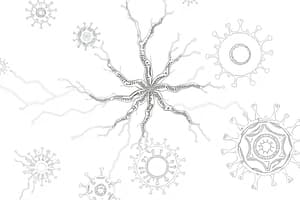Podcast
Questions and Answers
What is the source of the epithelial lining of inflammatory cysts?
What is the source of the epithelial lining of inflammatory cysts?
- Stimulation of the periodontal ligament
- Proliferation of connective tissue cells
- Proliferation of small odontogenic epithelial residues (correct)
- Inflammatory process within the granuloma
What is the mechanism of formation of inflammatory cysts?
What is the mechanism of formation of inflammatory cysts?
- Degeneration of the periodontal ligament
- Stimulation of the resident epithelial rests of Malassez caused by an inflammatory process within the granuloma (correct)
- Liquefaction of the granuloma
- Proliferation of connective tissue cells
What happens to the central cells of the mass in the mechanism of enlargement of inflammatory cysts?
What happens to the central cells of the mass in the mechanism of enlargement of inflammatory cysts?
- They proliferate rapidly
- They form a semipermeable membrane
- They become away from their source of nutrition and eventually degenerate (correct)
- They become necrotic due to excessive nutrition
What creates an epithelial lined cavity in the mechanism of formation of inflammatory cysts?
What creates an epithelial lined cavity in the mechanism of formation of inflammatory cysts?
What is the result of periapical infection as a sequalae to dental caries?
What is the result of periapical infection as a sequalae to dental caries?
Study Notes
Inflammatory Cysts Overview
- Epithelial lining of inflammatory cysts originates from the remnants of the reduced enamel epithelium or from the epithelial cells in the periodontal ligament.
- Formation of inflammatory cysts occurs through a sequence of inflammatory responses leading to the accumulation of fluid and cellular debris in a localized area.
- Central cells in the mass undergo necrosis or apoptosis, which contributes to the cyst's enlargement through necrotic material accumulation and inflammation-induced changes.
- An epithelial-lined cavity is created through the proliferation of the remaining viable epithelial cells around the necrotic core, resulting in cystic formation.
- Periapical infection stemming from dental caries leads to the development of periapical cysts, characterized by the encapsulation of infected tissue, inflammation, and the subsequent formation of a cystic cavity.
Studying That Suits You
Use AI to generate personalized quizzes and flashcards to suit your learning preferences.
Description
Test your knowledge of dentistry with this quiz on inflammatory cysts derived from odontogenic epithelial residues. Explore the mechanism of formation and understand the response to periapical infection resulting from dental caries.




